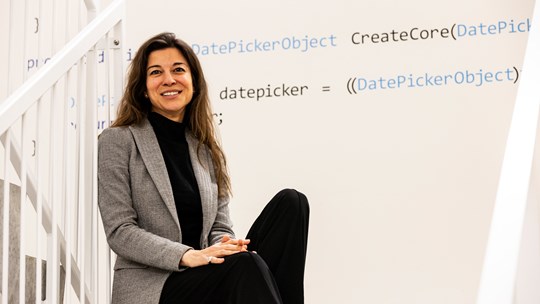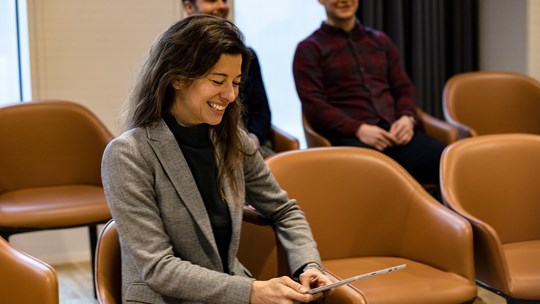Salary and negotiations
Go to salary
Salary can mean many things - get an overview of how you can benefit from IDA's salary tools.
Nana Bule, CEO of Microsoft, has never had to break through a glass ceiling. She therefore must remind herself that women in leadership are still facing barriers.

When Nana Bule meets IT directors of a certain age, they still remember her from her time as an IT specialist more than 17 years ago.
Not because they worked closely together, but because she was the only female IT specialist in Europe working for Microsoft.
Not long after, another woman began working as a database technology specialist in Sweden. In time, the percentage of female employees at Microsoft Denmark and Iceland grew to 36 percent.
In the meantime, Nana Bule made her way to the top.
While the number of female IT specialists has grown exponentially, the gender imbalance at Danish management levels has not seen any noticeable changes.
Today, 26.4% of Danish executives are women. This is the lowest percentage in the Nordic countries, and well below the OECD average of 32.4%.
The gender imbalance is the key reason that Denmark is ranked lower than countries such as Rwanda and Honduras on the latest Gender Gap list from the World Economic Forum.
Even though few could doubt that it is generally better to be a woman in the Danish welfare society, the low percentage of female leaders and parliamentarians is striking - even from a global perspective.
When Nana Bule contributes to an article about female executives, it is not entirely without reservation. In general, she finds that gender equality is often discussed but not enough is done about it.
Furthermore, she must think of herself as a female executive when she merely considers herself an executive.
“We do not talk about male executives, researchers or IT specialists, and I fear that this helps preserve certain stereotypes,” she explains in a light and airy meeting room in Microsoft’s head office in Lyngby.
“And I have never experienced that being a woman has been a disadvantage, although that’s probably because my mindset has been that there are no limitations. I was raised believing that I could do anything I set my mind to.”

In general, female executives rarely say that they have had to overcome more barriers than their male colleagues to reach the top. For Nana Bule however, this does not mean that those barriers do not exist.
“However, I am aware that I may have forgotten or ignored the challenges I have met underway. That is why I try to be conscious of this: it can sound so easy and even arrogant to say that I’ve never experienced problems - that the glass ceiling does not exist.”
"There are lots of barriers in our society that divide boys and girls. All the norms we place on ourselves; just look at “Janteloven”, or the expectations placed on us during childhood, in school, by our parents, the entire time we are growing up.”
If you ask Nina Smith, an economics professor at Aarhus University who has been studying equality in the labour market for 40 years, maternity leave, childbirth and gender stereotypes are a very important part of the gender imbalance among Danish executives.
“Hundreds of studies have shown that women suffer a 6-10% loss in salary and career setback when they have their first child.
The loss stems from the fact that women take 90% of parental leave at a time when their careers are just beginning to take off.
During their time at home with the child, they fall behind their colleagues who remain a part of company development.
But lost working hours are not the main reason why women's careers stagnate once they have a child because the same does not happen for men.
“Women would be able to make up for the lost time if it were only a matter of being away for 47 weeks. But they do not, and that is why something else must be going on. We call it statistical discrimination when women are passed over because of the assumption that they can’t work as much as men once they have children.”
An employer’s expectation that women work fewer hours than men does not come out of the blue.
After a long maternity leave, women often also stay at home during the child’s first day of sickness and they are responsible for most household chores. If you want to be a bit cynical, women are not as good workers as men, admits Nina Smith.
Nana Bule,
CEO, Microsoft Denmark
However, the difference has its roots in the maternity leave system that, according to her, creates the expectation that a real woman should take on most of the responsibility for raising children and organising the household.
“Politicians have reinforced gender stereotypes in the way maternity leave is organised. Before the 1970s, when there was no maternity leave, women who wanted to reach the top did not take as much maternity leave. You could say that we are financially preserving these gender stereotypes,” she explains.
When people are asked to describe a manager, they often highlight personality traits that are typically characterised as masculine. In psychology, this phenomenon is call “think manager – think male”.
This means that men are often perceived as ambitious and competent when they behave in a firm manner, whereas women are at risk of being labelled as domineering and unsympathetic if they demonstrate the same behaviour,” says Christina Lundsgaard Ottsen, who has a PhD in psychology and works on diversity and inclusive leadership for Cfl (Center for Ledelse - a management consultancy).
One of the most well-known studies on this phenomenon stems from Colombia Business School in the US. A team of graduate students were given a case about a successful entrepreneur who had started their own business in Silicon Valley and was now the CEO.
Half of the team were given a case where the CEO was named Howard, while the rest were given a case where the CEO was named Heidi. Other than the names, the descriptions were identical.
“The students who read the description of Howard felt that he was a competent and visionary leader who they’d like to work for. The students who got Heidi also found her competent, but they did not want to work with her because she seemed arrogant and selfish,” explains Christina Lundsgaard Ottsen.
A similar study was completed in Denmark in which employers were asked to assess a CV with either Allan, Ali or Alice on it. The names also had an affect here and as a result, Allan was assessed to be more competent than Ali and Alice.
"This is an example of what we call performance bias. If you do not fit the stereotypical idea of what a leader looks like, you will have to make an extra effort to prove yourself. Research shows that women are more likely to be judged on their performance, while men are judged on their potential,” explains Christina Lundsgaard Ottsen.
American studies have shown that male managers are more likely to describe having their potential spotted by an older mentor and that they had help reaching their current position. It is a bit of a caricature, but you could say that it is easier to imagine that Allan would be a better manager than Alice since the last three managers were also named Allan.

For the CEO of Microsoft, Nana Bule, a decisive factor was that her previous bosses spotted her potential before she did.
“I was lucky to work with managers - male managers - who encouraged me early in my career. Looking back, I can see that there was a definite shift from when I was being encouraged and helped to move forward and when I took the reins myself and knew what I wanted.”
Women do not begin to disappear until higher executive positions.
Even in technical sectors, where men are often in the majority, there is a relatively high degree of equality between men and women at the first management level, also referred to as first-line managers, i.e. managers who are only responsible for staff,” says Christina Lundsgaard Ottsen.
After this level however, female managers become few and far between.
“The requirements for managers change the higher up one climbs. First-line managers who are responsible for a team can usually get by using a very traditional managerial style, where they set the course and expect employees to follow it”.
"But when you are promoted and need to lead other managers, things become more complex because they’re held accountable to other stakeholders and their employees. This requires a more inclusive and flexible managerial style.”
We now return to the Howard/Heidi issue. Women are penalised for displaying firm and traditional masculine behaviour, and that is why they adopt a more inclusive managerial style that suits higher leadership levels.
However, women are passed over before they make it that far because they do not display the more straightforward managerial style that is expected of first-line managers.
Bringing more women into all levels at Microsoft - both as leaders and specialists - is a key issue for Nana Bule.
“Partly because we need a more extensive talent pool and partly because I sincerely believe products, solutions and consultancy are improved when they reflect the society and clients we work for.”
The positive gains have also been demonstrated in scientific studies that have set up homogenous groups and heterogeneous groups and compared their ability to do various tasks, says Christina Lundsgaard Ottsen.
The homogenous groups consisted of members with similar personality types and appearance, while the heterogeneous groups consisted of members who differed on those parameters.
In the study, both groups were asked to do a task and then evaluate the process and result themselves.
“The homogenous groups worked together quickly. There were many high fives and good energy. Afterwards, they felt that they had done the task well because they had been working together with some smart people. However, the problem is that we can see a lot of blind spots in their evaluations. Which means that they have not looked at the problem very thoroughly.
The complete opposite happens when you put together a group of individuals who do not resemble each other physically or in their personality.
“They don’t have the same positive experience because they feel it has been full of conflict. However, even though they do not feel as though they did the task well enough, we can see that they have been better at seeing the full scope of the problem. The most important element was a good leader who was open to different perspectives while ensuring that the group was working towards the same goal.”
According to Christina Ottsen, a 70-30 split is the “magic limit” where gender equality is just enough for diversity to come into play. If a gender makes up less than 30%, it will be considered a minority, and this will typically mean that they are more cautious when expressing views that differ from the majority.
If women make up more than 30% of a management team or a board of directors, they will, paradoxically, no longer be looked upon as women, but as individuals with differing points of view.
"This means that they will not be viewed as having a woman’s perspective, but rather as having their own perspective. Research shows that reaching this magical one-third percentage increases profits and the well-being of employees.”